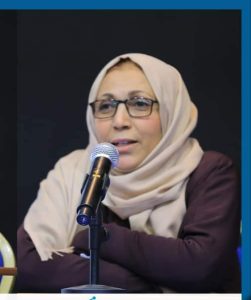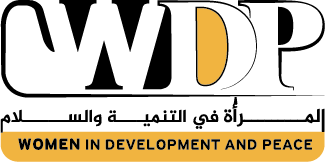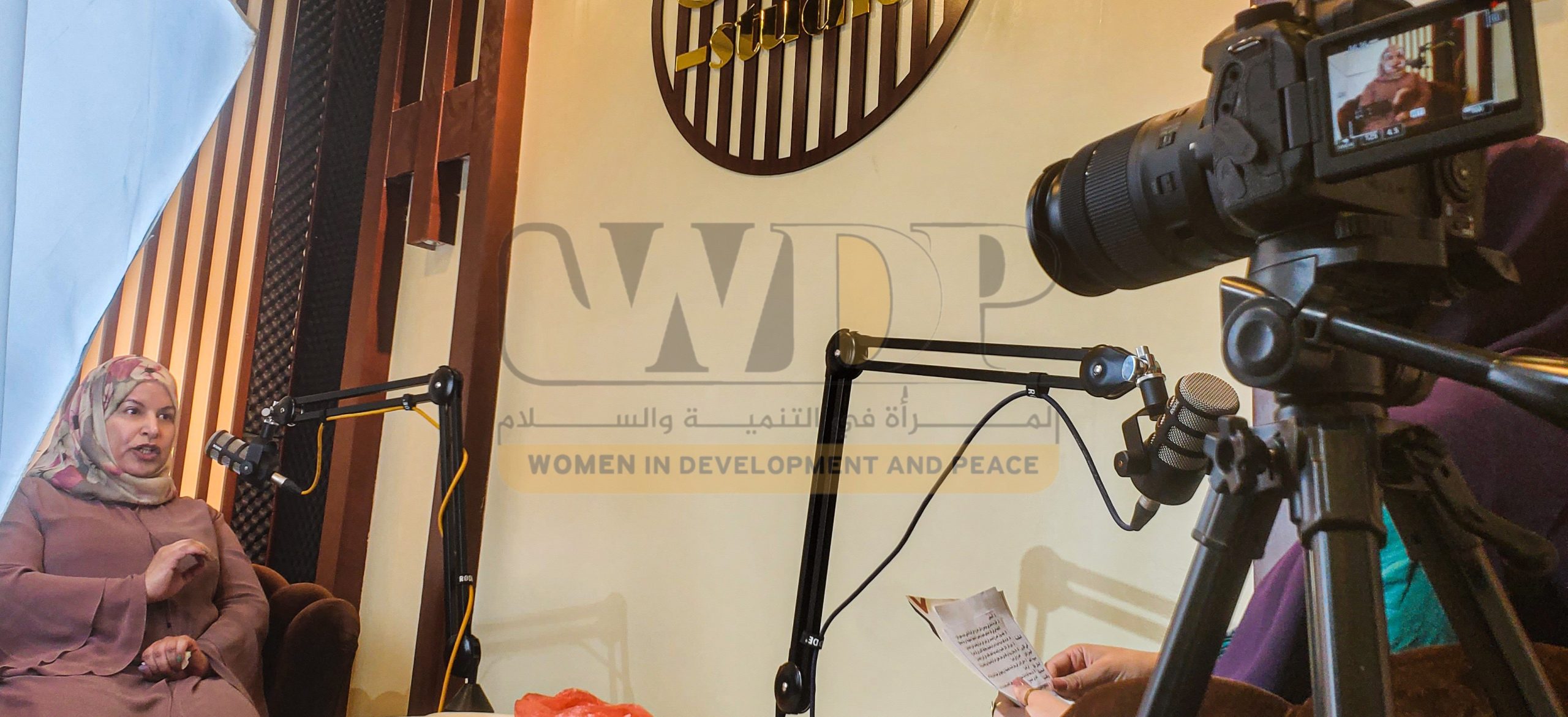Women in Development and Peace – Hebah Mohammed
In the world of Yemeni media, women pioneers shine, inspiring with their strength and courage in facing challenges. They express their voices with confidence and achieve exceptional success in a field that has long been dominated by men’s voices. In this report, we will take an inspiring journey to explore the success stories of Yemeni women in the field of media. We will uncover their personal stories, learn about the challenges they faced, and how they overcame them with strength and determination.
Media women of the modern era are a driving force for change. These pioneering women work to break social and cultural constraints and encourage women to achieve their aspirations in the world of media. Yemeni women are capable of changing the world through the power of their pens and voices.
Samia Al-Ansi: The Anthem of Dreams and Challenges in the Yemeni Media World
 The media personality Samia Al-Ansi says, “My beginnings were almost in the mid-seventies – I was barely fourteen years old – when my interest in radio work began to emerge from school activities, such as participating in the school radio’s poetry segments. Also, through playing with my peers in the neighborhood in Taiz city, through the love of recitation, singing songs and reciting poems in front of them, and creating a state of passion that never tires, until my father decided to take me to Taiz Radio to participate in children’s programs; this was my first start in radio work, which lasted for almost forty years.”
The media personality Samia Al-Ansi says, “My beginnings were almost in the mid-seventies – I was barely fourteen years old – when my interest in radio work began to emerge from school activities, such as participating in the school radio’s poetry segments. Also, through playing with my peers in the neighborhood in Taiz city, through the love of recitation, singing songs and reciting poems in front of them, and creating a state of passion that never tires, until my father decided to take me to Taiz Radio to participate in children’s programs; this was my first start in radio work, which lasted for almost forty years.”
This was at the end of the sixties and the beginning of the seventies, a time described by Al-Ansi as the “good old days”. That period carried innocence and purity in people’s lives; they lived under its shadow. Life was simple and humble, completely devoid of social disparities, even in different living conditions. Boys and girls played together in the neighborhood, and these moments represented their entertainment world, which they never tired of. They enjoyed simple games they made themselves.”
Since entering school in the first grade in 1969, Samiya has been fond of recitation on the school radio and has actively participated in presenting morning assembly segments. The school radio became her first passion, and she was eager to participate in all school events, such as Mother’s Day and national holidays. Her father played a major role in supporting her, as he wrote poems for those occasions.
Al-Ansi says, “In the audio media, which represents a space of creativity and positive influence in shaping the lines of the radio message, in order to elevate the collective awareness of people, undoubtedly, the most beautiful thing about this profession is its exceptional moral, creative, and ethical aspects.”
She continues, “By practicing it, its rules and characteristics differ from any other profession, because its impact is like a sparkle that illuminates the soul, mind, and imagination of the recipient, through the art of writing and presenting the word. This state remains the link between the voice of the broadcaster and the heart of the recipient; it does not end, whether the creator is still working or has stopped working.”
She alludes to this by saying, “Among the giants of media and words, there are those who left a documented legacy of creativity in radio libraries across various aspects of life. Despite their departure, they enriched people’s lives, shaped their consciousness, and elevated their taste. However, in the end, the final word lies with age when it comes to summarizing the creativity of media professionals. It’s about reaching the legal retirement age, passing the torch to those who follow, and providing opportunities for others who continue to thrive at the peak of their contributions and innovations. Such is the cycle of life.”
Challenges for Female Journalists Breaking from the Norm
As for the obstacles and challenges that the media faced in the past, Samia Al-Ansi is one of the media presenters of the past who suffered from injustice, arbitrariness, and neglect of rights. However, hope remains alive and enduring among the atmosphere of this profession. Today’s female media professionals can overcome those challenges, which may not only affect their financial rights but also their literary status and their valuable role as a social party that has an active and influential role in the movement of society and people. This enables them to shape a purposeful and serious media message, instead of just investing their voice in many advertising and commercial materials.
Al-Ansi mentioned some of the obstacles and challenges that have taken Yemeni media professionals out of their proper framework by saying, “The spread of many commercial radio stations aimed at profit, and the ease of financial gain through the exploitation of the noticeable flow of media college outputs, and the rush to practice the profession without experience, qualification, or even knowledge of the basics of radio work, its rules, technical and sound standards.”
She continued, “Also, the absence of professional role models and experts from the centers of management and decision-making, and the guidance for these stations and satellite channels, leads to the dominance of the media message and the radio map with all its random cultural materials and programs, which lead to the ignorance of people’s minds with misconstrued behavioral concepts, and with ideas and topics far from the concerns and urgent issues of the people that should be addressed and touch their daily suffering.”
She also pointed out that many programs undermine people’s taste and affect their social culture and overall behavior. Offensive words and expressions often dominate the feelings of the audience, perpetuating violence, abuse, regionalism, bullying, and belittling of others in various programs.
She further added, “Incorrectly portraying emotions and feelings in the name of love and romance in programs targeting young audiences results in a distorted view of emotional relationships. There is a clear failure in presenting the noble meanings associated with such relationships and intimate experiences that some channels broadcast during their late-night slots. Instead, the media message should place them within the proper context by educating young people about sanctifying these emotions and handling them appropriately, in line with the society’s culture and privacy, rather than indulging in excess and debauchery.”
Al-Ansi believes that all this excessiveness from some channels has diminished the status of media professionals and their positive impact on society. Her thoughts and knowledge have been confined to these trivial topics and messages, leaving her vulnerable to this cultural, intellectual, and media flattening, as if she were merely a commodity in front of the microphone—a fragile approach to attract listeners rather than benefiting them.
Al-Ansi questions, “Isn’t all this downplaying of her elevated media role alongside her colleague affecting her moral standing in people’s hearts? In addition to what I mentioned, there are other reasons for this neglect, which have led the media professional astray from her true content. Among these reasons is the long-standing negligence by responsible media entities in supporting the female workforce and pushing them toward their deserved achievements.”
She also highlights that one of the challenges is the exclusion of programs from the landscape of audio and visual media, along with policies that should elevate people’s awareness of the crucial role of female media professionals in societal progress. Unfortunately, they are not adequately supported in overcoming the conservative views regarding women’s participation in media. The society is still governed by a culture of unjust stigma, and there remains a clouded perception of this profession, influenced by outdated customs and traditions. These outdated norms continue to perceive women’s engagement in various media outlets as audacity.
Al-Ansi emphasizes that another significant cause of this neglect is the persistence of male-oriented upbringing within families and society. This upbringing perpetuates a diminished view of women’s status, capabilities, and potential. Regrettably, these cultural biases have influenced decision-makers, eroding their trust in women’s ability to hold sensitive leadership positions in the media. Consequently, female professionals continue to face arbitrary treatment and their pleas for justice often fall on deaf ears.
She also points out that Yemeni female media professionals suffer from exclusion and lack of empowerment in terms of qualification and strategic planning for media policies. Whether through internal or external participation in conferences and international seminars, they are often excluded from media teams covering presidential delegations, regardless of their competence. This exclusion blatantly disregards the principles of Arab and international media.
It emphasizes that if media professionals do not address such artificial challenges along their proper career path and the fabricated difficulties they encounter, it would limit their positive impact and active role in shaping public consciousness culturally and morally, alongside their fellow media colleagues. They have rightfully earned their status and rights, and they are always capable of facing challenges and overcoming them.
The meeting concluded with Al-Ansi stating, “From here, and with our trust in the masters of the word, those who believe in their value and recognize their literary, material, and administrative significance, after these long years for some of them—years spent in the media field oscillating between hope and mirage, competence and the neglect of rightful recognition. And for today’s female media professionals—I hope they do not encounter the same injustice and lack of deserved status that their predecessors faced.”
Safia Al-Ansi: The First Female Voice in Yemen
We began working in radio while we were elementary school students. It was during a school event at Arwa School, the first girls’ school in Taiz. A radio team came to record the event, and afterward, some of my colleagues and I were offered the opportunity to work in radio. At that time, radio lacked a female voice, and we underwent an examination in voice and language.”
Thus began Safia’s account of her initial journey in radio. She continued, “Working in radio was a challenge, but it had a unique charm for inspiring women. We worked diligently and passionately during that diverse period. We had a group of wonderful mentors who provided us with support and guidance. We learned language rules and expression, and participated in various programs that helped us develop our abilities and refine our ideas.”
Regarding the individuals who supported and trusted Safia at the beginning of her career, she said, “We were fortunate to interact with inspiring educators such as Mr. Hassan Al-Azzi, Mr. Abdul Qader Al-Shibani, and Mr. Abdul Rahman Mutahar. They served as role models and instilled confidence in us to continue in this field. Additionally, there were two creative radio broadcasters, Faten Al-Yousfi and the late Raufa Hassan, from Sana’a Radio, who also provided us with support and encouragement.”
She continues, “And I began working as an official radio presenter, thanking Allah and appreciating that my family was enlightened and understanding. They encouraged me, even though other distant family members were opposed. By the way, we presented all kinds of programs. At one point, Minister of Information, Mr. Ahmed Al-Marwani, listened to the children’s program I hosted and remarked, ‘A child presenting a children’s program!’ In a supportive gesture, he granted me a reward.
Regarding my transition from the field of media to medicine, I continued my studies in the morning while working in radio during the evenings. I completed my preparatory and secondary education. Despite the success and encouragement, I received from everyone in the radio field, I had a desire to study medicine. I obtained a scholarship to pursue medical studies, and today, I have been working in the medical field for 40 years. A new generation has taken up the mantle after us, including esteemed colleagues such as Amat Al-Alim Alsoswa and Samia Al-Ansi, among others, whom we are proud of and hold in high regard.”
She concluded her speech by saying, “At this age and in this position, I express my gratitude and appreciation to everyone who stood by me or alongside my female colleagues who came after me and proved their presence. Whether from their families or colleagues at work, we take pride in what we have achieved so far. However, we continue to strive for continuous improvement and development, both in my medical profession and beyond. We recognize that the road ahead is still long and filled with challenges, but we remain determined to fulfill our role in serving the community.”

